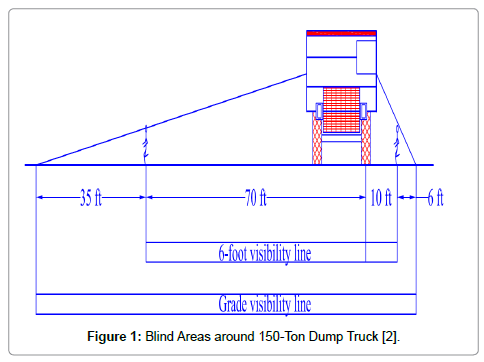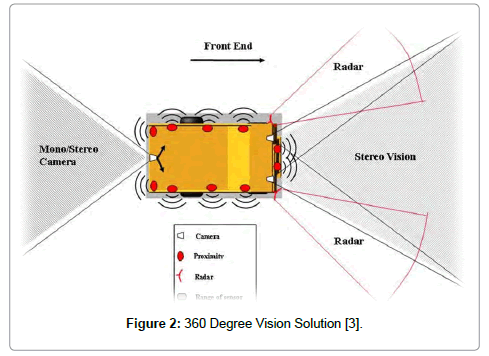Editorial Open Access
Research Advances in Augmented Truck Vision for Safe Surface Mining Operations
Samuel Frimpong*
Department of Mining and Nuclear Engineering, Missouri University of Science and Technology, USA
- *Corresponding Author:
- Samuel Frimpong
Professor and Chair
Department of Mining and Nuclear Engineering
Missouri University of Science and Technology, USA
Tel: 573-341-4753
E-mail: frimpong@mst.edu
Received Date: December 04, 2013; Accepted Date: December 05, 2013; Published Date: December 06, 2013
Citation: Frimpong S (2013) Research Advances in Augmented Truck Vision for Safe Surface Mining Operations. J Powder Metall Min 2: e125. doi: 10.4172/2168-9806.1000e125
Copyright: © 2013 Frimpong S. This is an open-access article distributed under the terms of the Creative Commons Attribution License, which permits unrestricted use, distribution, and reproduction in any medium, provided the original author and source are credited.
Visit for more related articles at Journal of Powder Metallurgy & Mining
The creation and maintenance of a healthy working environment in surface mining operations require sustained efforts in pursuing advanced research initiatives toward the development and deployment of powered haulage technologies. The Mine Safety and Health Administration (MSHA) indicates that, out of the 250 fatalities reported from 1998 to 2002 for surface mining operations, 40% was attributed to powered haulage. Within the same period, MSHA reports that 14% of total days lost and 9% of lost time injuries were attributed to powered haulage [1]. Ruff [2] states that about 675 accidents and 21 fatalities, involving powered haulage equipment, occur each year in surface mining operations. A significant 20 percent of these accidents involve off-highway dump trucks. Many practical solutions and fundamental research have been carried out to improve truck-haul road engagement and reduce dump truck collisions [3]. However, truck tirehaul road engagement, and collision problems persist in surface mining operations. Any meaningful and practical solutions must be focused on the entire truck operating paradigm from loading through loaded and empty haulage to dumping operations. Attention must focus on truck dynamics, collision avoidance and overall situational awareness of operator’s environments. Dump truck dynamics are essential for ensuring stability, and effective tire-ground engagement for efficient operations in challenging terrains. Collision and enhanced situational awareness in difficult environments are also major challenges associated with the operation of these dump trucks as a result of the increasing “blind” areas around the trucks and the operating environment. The sources of these likely collision hazards and lack of perceptual awareness include machine design, which provides limited operator’s field of view, terrain geometry problems, random intrusions by humans and animals, low clearance between passing trucks on horizontal curves, and problems at service stations (Figure 1).
Operators face enormous challenges in interacting with mine layouts and haul road environments during truck operations. Two major interrelated challenges are an operator’s limited vision due to the extensive “blind” areas around the truck and truck stability during an operator’s response to intrusive dangers. The extent of this blind area is a function of truck size, position of operator’s cabin, geometry of obstruction and haul road (especially horizontal and vertical curves) and environmental challenges to visibility (in terms of fog, mist and night conditions). Figure 1 shows the frontal and planar blind areas around a 150-ton haul truck on a horizontal plane. It shows that the operator’s vision is limited on both sides of the truck. The ground level can only be seen after 105 feet away from the operator’s cabin on the right side and 16 feet on the left side and a 6-foot person can be sighted by an operator 70 feet away from the right side and 10 feet away from the left side.
Dump truck stability is a major concern in surface mining operations, because the trucks travel on haul roads with difficult traffic challenges. Haul road terrains are uneven, curvy and are sometimes characterized by high grades (10-12%). These problems may be augmented by the presence of ice or snow, mud, pot holes and tire tread wear. Truck stability on such haul roads is critical anytime an operator responds to an intrusive danger. An operator may increase or lower speed, swerve, or stop to avoid collision. Depending on the prevailing haul road conditions and the proximity of an intrusive object, vehicular control in response to perimeter sensing may result in truck slippage, steering control loss, fatal accidents with corresponding injuries and equipment losses. Research and field instrumentation have been carried out to test various technologies for solving problems of dump truck operator visibility in surface mining applications. Ruff [4] discussed a number of these technologies and their limitations, which include the preview radar, the electronic tag-based, the GPS-based proximity warning and the computer-assisted stereo-vision systems. The preview radar detection system is limited due to its narrow radar beams. The tag technologies are limited because it is difficult to tag foreign objects like passer-bys, large rock falls and animals. The GPS technologies will also require each worker to wear a receiver GPS system. Another challenge is the kinematics and dynamic control of the truck tire-haul road terrain interactions. In challenging haul road conditions, the lateral/forward motion, normal, tangential and lateral reactive forces can cause major accidents. Frimpong et al. [5] developed a simulation algorithm to test an automated dump truck in a large-scale surface mining environment. The ability to control and manage difficult haul road trafficability by trucks is an important domain for improving truck haulage safety. The need for practical and economic technologies for solving these problems is vital toward safety improvements in the workplace to ensure operator safety, equipment integrity and attainment of optimum production targets.
Current research by the author and his research team in augmented truck visualization provides a strong basis for developing technologies to improve truck haulage safety in surface mines. These improvements will save many lives, increase efficiency and equipment longevity. Intelligent sensing derived from comprehensive truck dynamic models and collision avoidance technologies will improve dump truck operator’s control and visibility around the truck. This research program will also advance intelligent sensing through fundamental and applied research and open new frontiers in micro- and macro-intelligent mining systems engineering and surface mine production engineering. This research covers a broad spectrum including truck kinematics and dynamics, truck-haul road dynamics and soil load deformation mechanics and intelligent target sensing and vision engineering. These areas constitute a significant scientific envelope for a healthy surface mining enterprise. Collision avoidance systems will improve operator and equipment safety. It will also create opportunities for developing new computational intelligent algorithms, simulation platforms, and truck operating standards for addressing fundamental problems in powered haulage.
The primary objective is to develop intelligent sensing technologies with dynamic control and stability and collision avoidance capabilities through fundamental and applied research (Figure 2) [6]. The elements of this objective include: (i) minimizing haul truck fatalities in the workplace to ensure operator safety and efficient operations; (ii) developing kinematics and dynamic models of truck-haul road interactions using multi-body physics and virtual prototype engineering; (iii) developing an intelligent sensory system for sensing extreme kinematics and dynamic deviations on haul roads; (iv) developing intelligent collision avoidance technologies for sensing intrusive objects within a truck’s blind areas over 3600 range; (v) developing an intelligent algorithm for false alarm mitigation using multi-sensor and temporal information fusion; (vi) developing an integrated system for situational awareness, augmented visualization and operator interface; (vii) carrying out extensive laboratory and field testing on developed technologies in selected surface mining sites; (viii) providing detailed error variance and analysis for system parameterization, tolerance testing for confidence measures and calibration using stochasticoptimization algorithms.
As part of the research program, existing research infrastructure and facilities will be expanded to cater for the increased research capacity. This collaboration will bring together the research infrastructure of Missouri S&T and the resources the surface mining industry for achieving the major research goals. The results from this research program will be disseminated at various levels for motivating advanced and innovative research, promoting public education, creating new understanding, investing in new technologies, creating interests in high school students and contributing to the Federal and State Governments’ initiative on “Industries of the Future”. The Federal and State Governments are advancing this initiative to promote a new generation of business enterprises, which capture current and future advances in computational intelligence and information technologies in their management and operations. Research ideas, will be published in reputed refereed journals and presented at conferences, workshops and seminars to motivate advanced and innovative research initiatives. Publication of research results will also lead to investment in new and advanced intelligent technologies for efficient and economic mining operations.
References
- MSHA (2004) Distribution of Fatalities by Accident Class: Surface Mining Operations, 1998–2002.
- Ruff T (2002) Hazard Detection and Warning Devices: Safety Enhancement for Off-Highway Dump Trucks. A Compendium of NIOSH Mining Research. Washington DC.
- Frimpong (2013) Current Research Initiatives in Augmented Dump Truck Visualization. Research Working Paper, Heavy Mining Machinery Research Group. Missouri S&T, Rolla, MO.
- Ruff TM (2001) Monitoring Blind Spots–A Major Concern for Haul Trucks. E&MJ 202: 17-26.
- Frimpong S, Changirwa R, Szymanski J (2003) Simulation of Automated Dump Trucks for Large-Scale Surface Mining Operations. International Journal of Surface Mining, Reclamation & Environment 17: 1.
- Frimpong S, Y Li, Aouad N (2007) Intelligent Machine Monitoring and Sensing for Safe Surface Mining Operations. ERTEP Conference, Accra, Ghana.
Relevant Topics
- Additive Manufacturing
- Coal Mining
- Colloid Chemistry
- Composite Materials Fabrication
- Compressive Strength
- Extractive Metallurgy
- Fracture Toughness
- Geological Materials
- Hydrometallurgy
- Industrial Engineering
- Materials Chemistry
- Materials Processing and Manufacturing
- Metal Casting Technology
- Metallic Materials
- Metallurgical Engineering
- Metallurgy
- Mineral Processing
- Nanomaterial
- Resource Extraction
- Rock Mechanics
- Surface Mining
Recommended Journals
Article Tools
Article Usage
- Total views: 15485
- [From(publication date):
December-2013 - Apr 02, 2025] - Breakdown by view type
- HTML page views : 10822
- PDF downloads : 4663


